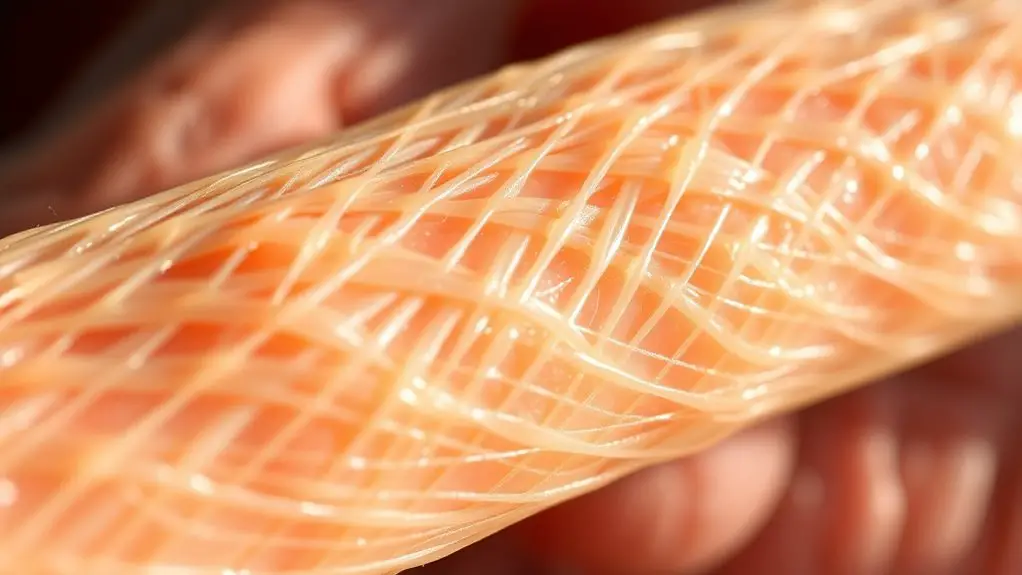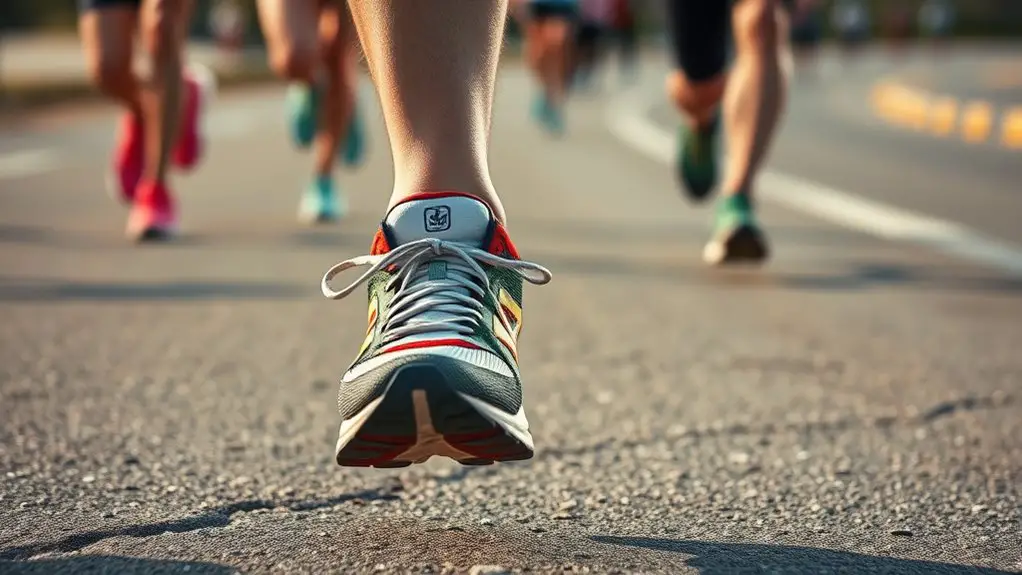Collagen plays an essential role in repairing ligaments and tendons, providing strength and elasticity. It's the primary protein that supports tissue integrity during healing. Different collagen types, like Type I and Type III, contribute to their structure and function, promoting resilience. During the healing process, collagen synthesis increases, which aids in regenerating new tissue. Factors like nutrition and therapeutic approaches enhance collagen production and repair. Discover more about how collagen supports recovery and overall joint health.
Understanding Collagen: The Essential Protein
Collagen is often hailed as the backbone of our connective tissues, playing a critical role in the structure and function of ligaments and tendons. This essential protein provides the strength and elasticity needed for your body to move freely. When you think about your ability to run, jump, or even stretch, collagen's contributions become clear. It forms a supportive scaffold, ensuring that your ligaments and tendons can withstand the stresses of daily life without tearing or becoming injured.
Understanding collagen's significance in your body empowers you to take charge of your health. It's not just about repairing injuries; it's about maintaining that freedom of movement you cherish. By nurturing your collagen levels through a balanced diet and healthy lifestyle, you can promote your body's resilience. Embrace this knowledge, and you'll find yourself better equipped to enjoy the activities that bring you joy and a sense of liberation.
Types of Collagen in Connective Tissues
When it comes to connective tissues, understanding the different types of collagen is key. Each type plays a specific role in the function and repair of ligaments and tendons. Let's explore how these collagen varieties contribute to the strength and stability of these essential structures.
Collagen Types Overview
Understanding the various types of collagen is essential for grasping their roles in connective tissues like ligaments and tendons. Collagen comes in several forms, each with unique properties that serve different purposes. Here are four notable types:
- Type I: The most abundant type, providing strength and structure to tendons and ligaments.
- Type II: Primarily found in cartilage, it offers support and cushioning in joints.
- Type III: Often found alongside Type I, it helps in the formation of new tissue during repair.
- Type IV: Located in basal membranes, it plays an important role in filtration and support.
Functions in Ligaments
In ligaments, the primary function of collagen is to provide tensile strength and elasticity, enabling them to withstand the forces exerted on joints. Collagen fibers are organized in a crimped pattern, allowing ligaments to stretch and return to their original shape. This unique arrangement helps maintain joint stability while permitting a degree of movement. There are different types of collagen in ligaments, primarily type I, which is strong and resistant to stretching, and type III, which provides a supportive matrix during healing. By understanding how collagen functions, you'll appreciate its role in keeping your body flexible and resilient. When ligaments are injured, promoting collagen synthesis through proper nutrition and rehabilitation can enhance recovery, letting you move freely again.
Functions in Tendons
Collagen plays an essential role in the function of tendons, giving them the strength and flexibility needed to handle the high tensile forces during movement. You might not realize it, but the types of collagen in your tendons are critical for their performance. Here are some key functions:
- Provides tensile strength: Collagen fibers allow tendons to withstand intense pulling forces.
- Facilitates flexibility: Different collagen types help tendons absorb shock and adapt to various movements.
- Supports healing: Collagen is fundamental in the repair processes following injuries, fostering tissue regeneration.
- Connects to muscles and bones: Collagen guarantees a strong attachment, allowing for effective force transmission during physical activity.
The Structure of Ligaments and Tendons
When you think about ligaments and tendons, it's important to contemplate their unique compositions. Ligaments are primarily made of collagen fibers that provide stability, while tendons have a structure that allows for flexibility and strength. Understanding these differences helps you appreciate how each functions in your body.
Composition of Ligaments
Ligaments and tendons are crucial connective tissues that provide stability and facilitate movement in the body. Understanding their composition helps you appreciate how they function. Ligaments primarily consist of:
- Collagen fibers: These provide tensile strength and elasticity.
- Elastic fibers: These allow ligaments to stretch and recoil.
- Ground substance: This gel-like material helps with hydration and nutrient transport.
- Cells: Fibroblasts produce collagen and maintain the tissue.
Together, these components support the ligaments' role in connecting bones and stabilizing joints. When you think about your body's movement, remember that these structures are crucial for flexibility and strength, allowing you to enjoy an active, unrestricted life. Embracing this knowledge empowers you to take care of your ligaments better.
Composition of Tendons
Tendons play an essential role in connecting muscles to bones, enabling movement and providing stability during physical activities. They're primarily made up of collagen fibers, which give them strength and flexibility. These collagen fibers are organized in a parallel arrangement, allowing tendons to withstand the tensile forces generated during muscle contractions. Besides collagen, tendons contain elastin, which contributes to their elasticity, allowing for some stretch without losing integrity. The ground substance, composed of water, glycoproteins, and proteoglycans, also plays a role in maintaining tendon health. Understanding the composition of tendons helps you appreciate their resilience and importance in everyday movements, ensuring you can enjoy your activities freely and without restriction.
Functionality and Flexibility
The intricate structure of ligaments and tendons is key to their functionality and flexibility. These connective tissues are designed to withstand high tensile forces while allowing for a degree of movement. This balance is essential for your freedom of motion in daily activities.
Here's what makes them special:
- Collagen fibers: Arranged in a parallel structure, they provide strength and elasticity.
- Elastin: Allows for stretching and returning to the original shape, enhancing flexibility.
- Ground substance: A gel-like matrix that supports cells and helps absorb shock.
- Cellular composition: Includes tenocytes that play a role in tissue repair and regeneration.
Understanding this structure helps you appreciate how your body moves and recovers.
The Healing Process of Ligaments and Tendons
Although injuries to ligaments and tendons can be quite painful, understanding the healing process can help you navigate recovery more effectively. When you suffer an injury, your body goes through several stages: inflammation, repair, and remodeling. Initially, inflammation occurs, signaling your body to start the healing process. You might notice swelling and pain, which are normal responses.
During the repair phase, your body begins to produce new tissue, gradually replacing the damaged area. This is where patience is essential; rushing this phase can lead to further injury. Finally, in the remodeling stage, the new tissue strengthens and matures, allowing you to regain full function. Incorporating strength training during recovery can help enhance tendon resilience and support the healing process.
Throughout these stages, you'll want to listen to your body. Rest is vital, but gentle movement can also promote healing. Embrace this time as a chance to learn about your body and how to nurture it back to health.
Collagen Synthesis and Its Importance in Repair
Collagen plays an essential role in the repair of ligaments and tendons, acting as the primary building block for the new tissue your body generates. When injuries occur, your body ramps up collagen synthesis to rebuild and restore strength. This process is vital for guaranteeing that your ligaments and tendons heal properly, allowing you to regain your mobility and freedom.
Key aspects of collagen synthesis include:
- Structural Support: Collagen fibers provide the framework for new tissue.
- Tissue Strength: Adequate collagen guarantees your repaired ligaments and tendons are resilient.
- Cell Communication: Collagen helps in signaling cells to promote healing.
- Elasticity Restoration: Proper collagen levels allow for flexibility in healed tissues.
Understanding collagen's importance in repair can empower you to take steps that support your healing journey, enabling you to return to the activities you love, strong and unrestricted.
Factors Affecting Collagen Production
Various factors can greatly influence collagen production, impacting the healing of ligaments and tendons. Understanding these factors is essential for anyone seeking to enhance their recovery.
| Factor | Description | Impact on Collagen Production |
|---|---|---|
| Age | As you age, collagen synthesis decreases. | Slower healing and weaker tissue. |
| Hormones | Hormonal imbalances can disrupt collagen levels. | Impaired repair processes. |
| Genetics | Your genetic makeup affects collagen types. | Influences tissue strength. |
| Stress | Chronic stress can negatively affect collagen. | Slower recovery and more injuries. |
Quality sleep is crucial for muscle repair and growth, further impacting collagen production and recovery outcomes.
Nutritional Support for Collagen Formation
To support collagen formation, you need to focus on key nutrients that play an essential role in this process. Foods rich in vitamin C, amino acids, and certain minerals can enhance collagen production. Exploring dietary sources of these nutrients can help you optimize your body's ability to repair ligaments and tendons.
Key Nutrients for Collagen
While your body naturally produces collagen, certain key nutrients play an important role in enhancing its formation and ensuring ideal repair of ligaments and tendons. To support your body's collagen synthesis, consider incorporating the following nutrients into your diet:
- Vitamin C: Essential for collagen synthesis and acts as an antioxidant.
- Proline: An amino acid found in proteins that helps stabilize collagen structure.
- Glycine: Another amino acid that promotes collagen formation and aids in tissue repair.
- Copper: Crucial for cross-linking collagen fibers, enhancing strength and stability.
Dietary Sources of Collagen
Incorporating specific foods into your diet can greatly enhance collagen production and support the repair of ligaments and tendons. You'll want to focus on nutrient-rich options that provide the building blocks for collagen synthesis. Here's a quick look at some excellent dietary sources:
| Food Source | Collagen Boosting Nutrients | Benefits |
|---|---|---|
| Bone Broth | Gelatin | Supports joint health |
| Chicken Skin | Collagen, Protein | Aids tissue repair |
| Fish (Salmon) | Omega-3, Collagen | Reduces inflammation |
| Berries | Antioxidants | Protects collagen |
| Leafy Greens | Vitamin C | Boosts collagen synthesis |
Therapeutic Approaches to Enhance Collagen Repair
As researchers explore ways to enhance collagen repair, a variety of therapeutic approaches have emerged that show promise in improving ligament and tendon healing. These methods aim to boost your body's natural healing processes and accelerate recovery. Here are some of the most intriguing strategies:
Innovative therapies are emerging to enhance collagen repair, boosting natural healing and accelerating ligament and tendon recovery.
- Platelet-Rich Plasma (PRP) Therapy: Utilizes components of your blood to stimulate tissue healing and collagen production.
- Stem Cell Therapy: Harnesses the potential of stem cells to regenerate damaged tissues and promote collagen synthesis.
- Biologic Scaffolds: Provides a supportive structure for collagen to grow, enhancing the healing environment.
- Topical Treatments: Includes growth factors and peptides that can be applied to injured areas, encouraging collagen formation.
The Role of Exercise in Ligament and Tendon Recovery
After exploring various therapeutic approaches to enhance collagen repair, it's clear that exercise plays a significant role in the recovery process for ligaments and tendons. Engaging in the right exercises can boost blood flow, delivering essential nutrients to the injured areas. This not only promotes collagen synthesis but also strengthens the surrounding muscles, offering better support and stability.
You don't have to push yourself to the limit; gentle, controlled movements can be just as effective. Activities like stretching, low-impact aerobics, and resistance training can help restore range of motion and improve function. Remember to listen to your body—if something feels painful, it's important to ease off.
Incorporating exercise into your recovery plan can empower you, allowing you to regain your strength and flexibility. Prioritizing rest is essential for peak performance, as it fosters resilience and freedom in your body. Embrace the journey, and let movement guide your healing process, as it fosters resilience and freedom in your body.
Future Directions in Collagen Research for Injury Repair
While current research has made strides in understanding collagen's role in injury repair, future directions are likely to focus on innovative therapies and biomaterials that enhance collagen synthesis and organization. You'll want to keep an eye on emerging trends that could change the game for recovery. Here are some exciting possibilities:
- Gene therapy: Techniques to stimulate collagen production at a cellular level.
- 3D bioprinting: Creating custom scaffolds that mimic natural tendon and ligament structures.
- Natural biomaterials: Using substances like silk or chitosan to foster a conducive healing environment.
- Nanotechnology: Delivering growth factors directly to the injury site for optimized healing.
As these advancements unfold, they could offer you greater options for recovery, ultimately leading to faster and more effective healing processes. Embracing these innovations can empower you in your journey towards rehabilitation.
Frequently Asked Questions
Can Collagen Supplements Speed up Ligament and Tendon Healing?
Imagine your body's orchestra, healing and harmonizing. Collagen supplements might just be that secret conductor speeding up ligament and tendon repair. They could enhance recovery, letting you reclaim your freedom to move with grace and strength.
Are There Any Side Effects of Collagen Supplementation?
You might experience mild side effects from collagen supplements, like digestive discomfort or allergies. It's always best to consult with a healthcare professional before starting any new supplement to guarantee it's right for you.
How Does Age Affect Collagen Production in Tendons and Ligaments?
As you age, your body's collagen production naturally decreases, leading to reduced elasticity and strength in tendons and ligaments. This decline can affect mobility and increase the risk of injuries, so staying active and healthy is essential.
Can a High-Protein Diet Improve Collagen Synthesis?
Can a high-protein diet boost collagen synthesis? Absolutely! By incorporating more protein into your meals, you're not just fueling your body; you're also supporting collagen production, which can enhance your overall health and well-being.
What Lifestyle Changes Can Support Collagen Health?
To support collagen health, you should stay hydrated, eat a balanced diet rich in vitamin C and antioxidants, avoid smoking, manage stress, and maintain a regular exercise routine. These changes can enhance your overall well-being.




